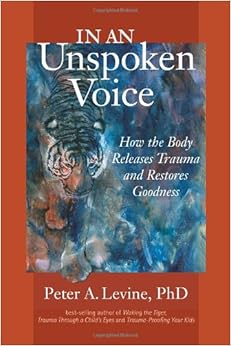
This is just a brief little article from Psych Central's World of Psychology blog, but it offers some nice introductory information on the benefits of somatic psychotherapies for trauma.
The two main models I like are Somatic Experiencing, developed by Peter Levine, and Sensorimotor Psychotherapy, developed by Pat Ogden. Both of these cost three arms and a leg to get trained in, but there are useful books.
Recommended Reading:
- Trauma and the Body: A Sensorimotor Approach to Psychotherapy by Pat Ogden (part of the Norton series in Interpersonal Neurobiology)
- Sensorimotor Psychotherapy: Interventions for Trauma and Attachment by Pat Ogden (also part of the Norton series) - Due out December 15, 2014
- Waking the Tiger: Healing Trauma by Peter Levine
- Trauma Through a Child's Eyes: Awakening the Ordinary Miracle of Healing by Peter Levine
- In an Unspoken Voice: How the Body Releases Trauma and Restores Goodness by Peter Levine
How Somatic Therapy Can Help Patients Suffering from Psychological Trauma
By Kay Khan
September 12, 2014
Whatever happens in our lives impacts our mind either consciously or unconsciously. Sometimes events — such as the unexpected death of a loved one, illness, fearful thoughts, near-death accidents or experiences — result in traumas. Psychological trauma causes damage to the psyche that occurs as a result of a severely distressing event.
How Somatic Psychotherapy Helps
Somatic psychotherapy is one of the best ways to help patients suffering from psychological traumas cope, recover and live a normal life. The word somatic is derived from the Greek word “soma” which means living body. Somatic therapy is a holistic therapy that studies the relationship between the mind and body in regard to psychological past. The theory behind somatic therapy is that trauma symptoms are the effects of instability of the ANS (autonomic nervous system). Past traumas disrupt the ANS.
According to somatic psychologists, our bodies hold on to past traumas which are reflected in our body language, posture and also expressions. In some cases past traumas may manifest physical symptoms like pain, digestive issues, hormonal imbalances, sexual dysfunction and immune system dysfunction, medical issues, depression, anxiety and addiction.
However, through somatic psychotherapy the ANS can again return to homeostasis. This therapy has been found to be quite useful in providing relief to disturbed patients and treating many physical and mental symptoms resulting from past traumas.
Somatic psychology confirms that the mind and body connection is deeply rooted. In recent years neuroscience has emerged with evidence that supports somatic psychology, showing how the mind influences the body and how the body influences the mind.
How it Works
The main goal of somatic therapy is recognition and release of physical tension that may remain in the body in the aftermath of a traumatic event. The therapy sessions typically involves the patient tracking his or her experience of sensations throughout the body. Depending on the form of somatic psychology used, sessions may include awareness of bodily sensations, dance, breathing techniques, voice work, physical exercise, movement and healing touch.
Somatic therapy offers a variety of benefits. It reframes and transforms current or past negative experiences, inculcates greater sense of oneself, confidence, resilience and hope. It reduces discomfort, strain and stress while developing a heightened ability to concentrate.
Some of the somatic methods that therapists use are titration and pendulated method. Titration uses a resource state, a place of safety. The patient is guided through traumatic memories and then the therapist asks the patient if he or she notices any change in the way they feel when the memory is revived. The physical stimulus is usually gentle and small. However, if physical symptoms occur, they are then attended to at length.
On the other hand, pendulated method refers to the movement between homeostasis and instability. Unlike titration, in this type of method, the patient is moved from a state of homeostasis to a state where physical symptoms are present. Then the patient is helped to return to the state of stability. In this method, discharge occurs. Discharge is stress that is stored by the nervous system. It can include discomforting experiences, nausea, twitching and flushing of the skin.
When somatic therapy sessions are completed, the patient often reports a feeling of being free, less stressful and more engaged with life. It decreases the level of physical pain and mental stress, too.
Disclaimer:
Unanihealth has provided this material for your information. It is not intended as a substitute for medical expertise and advice of your primary health care provider. We encourage you to discuss any decisions about treatment or care with your health care provider. The mention of any product, service, or therapy is not an endorsement by Unanihealth or its writers.
Sources:

No comments:
Post a Comment